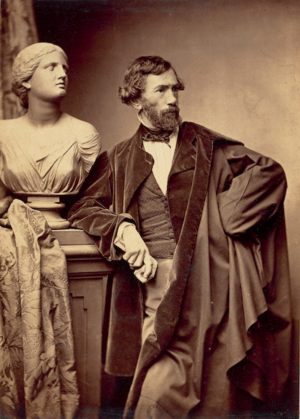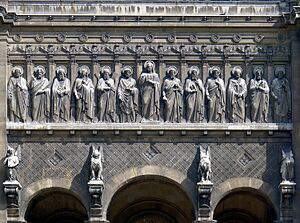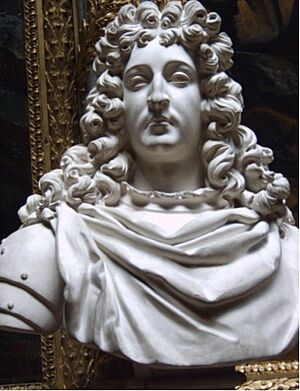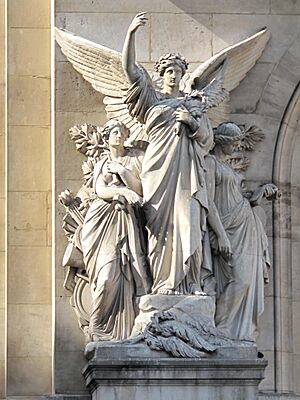François Jouffroy facts for kids
Quick facts for kids
François Jouffroy
|
|
|---|---|

|
|
| Born | 1 February 1806 |
| Died | 25 June 1882 (aged 76) |
| Occupation | Sculptor |
François Jouffroy (born February 1, 1806 – died June 25, 1882) was a famous French sculptor. He created many beautiful statues and artworks that can still be seen today in France.
Contents
Biography
François Jouffroy was born in Dijon, France. His father was a baker. From a young age, François showed a talent for art. He first went to a local drawing school in Dijon.
In 1824, he was accepted into the École des Beaux-Arts in Paris. This was a very important art school. In 1832, he won the Prix de Rome, a special award that allowed young artists to study in Rome, Italy. This helped him become a well-known sculptor.
Jouffroy often competed with another famous sculptor, Pierre-Jean David d'Angers, for big projects. However, during the time of the Second French Empire (1851–1870), Jouffroy still got to work on many public buildings. He helped decorate them with his sculptures.
From 1865 until he passed away, he was a professor at the École des Beaux-Arts. He taught many students who later became famous artists themselves. Some of his students included Augustus Saint-Gaudens and António Soares dos Reis. François Jouffroy died in Laval, Mayenne in 1882.
Famous Sculptures
François Jouffroy created many important sculptures throughout his life. Here are some of his most notable works:
Early Works and Awards
- "The Death of Orion" (1826): This sculpture helped Jouffroy win second prize in the 1826 Prix de Rome competition.
- "A Young Neapolitan Shepherd Crying Over His Tomb" (1835): This was the first sculpture Jouffroy showed at the Paris Salon, a famous art exhibition.
- "Capaneus Struck by Lightning Under the Walls of Thebes" (1832): This plaster sculpture won Jouffroy the 1832 Prix de Rome. It shows a powerful scene from Greek mythology.
Works for Public Buildings and Churches
- Holy Water Font (1844): Jouffroy made a beautiful marble font for the Saint-Germain l'Auxerrois church in Paris.
- The Four Evangelists (1851): He created sculptures of the four evangelists for the altar of the Église de Sainte Clotilde in Paris.
- Christ and the Twelve Apostles (1862): This large sculpture is a bas-relief (a type of carving that stands out from a flat surface) above the porch of the Église de Saint-Augustin, Paris.
- "The Arts and Sciences" (1855-1857): This sculpture decorates the front of the Pavillon Mollien at the Palais du Louvre in Paris. He also made two caryatides (sculpted female figures used as columns) for the same building.
- Statues for the Gare du Nord (1863): Jouffroy created statues representing the cities of Warsaw and Brussels for the front of the main train station in Paris.
Historical and Mythological Figures
- Bust of Lamartine (1843): A sculpture of the famous French writer Alphonse de Lamartine, located in the Musée Lamartine in Mâcon.
- Marie Leszczynska (1844): A bust of the former Queen of France, found at the Versailles châteaux.
- Bas-reliefs for Napoleon's Tomb (1851): Jouffroy created two white marble bas-reliefs for Napoleon's tomb at Les Invalides in Paris. One shows the Prince of Joinville giving Napoleon's coffin to King Louis-Philippe. The other shows the Prince of Joinville watching Napoleon's body being dug up on Saint Helena. These sculptures tell the story of the "Retour des cendres" (Return of the Ashes), when Napoleon's body was brought back to France in 1840.
- Statue of Napoleon as Lieutenant Bonaparte (1857): This statue in Auxonne celebrates Napoleon's time there as a young officer. Jouffroy also made a bas-relief for its base.
- "Ariadne Abandoned" (1853): This sculpture shows Ariadne, a figure from Greek mythology, after she was left by Theseus on an island.
- "Erigone" (1841): Another mythological sculpture, displayed at the Musée des Beaux-Arts in Dijon.
- Gaspard Monge (1839): A bust of Gaspard Monge, a famous French mathematician and inventor.
Other Notable Works
- "Cain After the Curse" (1838): This sculpture shows a very sad Cain after he killed his brother.
- "First Secret Confided to Venus" (1839): This is one of Jouffroy's most famous marble sculptures. It shows a young girl sharing a secret with the goddess Venus.
- Bust of Béat-Jacques de La Tour-Châtillon (1840): A plaster bust found in the galerie des batailles at the Château de Versailles.
- Valentin Haüy Statue (1843): Jouffroy created a statue of Valentin Haüy, who founded the first school for blind children. The statue is on the front of the Institute for Young Blind People in Paris.
- "Harmony" (1865): A plaster model of this sculpture is at the Musée d'Orsay. The full sculpture can be seen on the left side of the Paris Opera House. It is one of four groups of sculptures on the building's facade.
- "The Dawn" (1870): This sculpture can be found in the Jardin Marco Polo in Paris.
- Saint Bernard de Clairvaux (1877): A white marble sculpture of the saint, originally for a church in Paris, now in the Cathédrale Saint-Vaast in Arras.
- Bust of Henry Darcy (1858): This bust is on top of the Chateau d’Eau in Jardin Darcy, Dijon.
Images for kids
See also
 In Spanish: François Jouffroy para niños
In Spanish: François Jouffroy para niños








